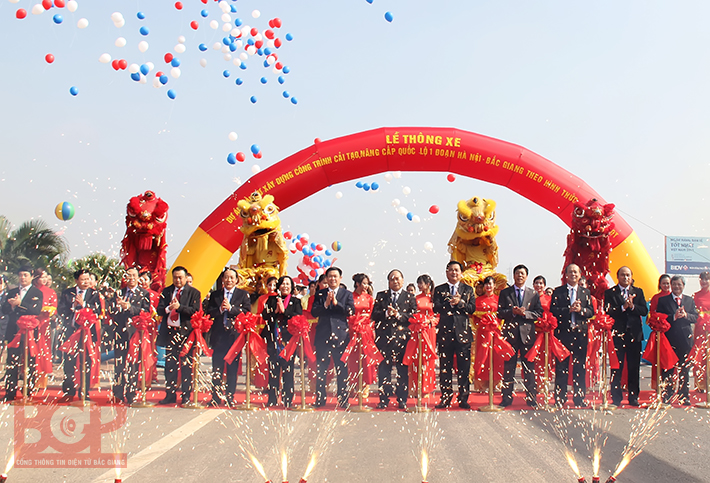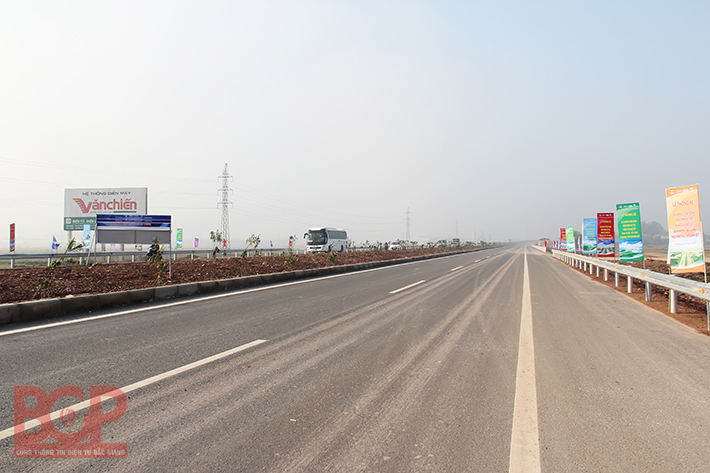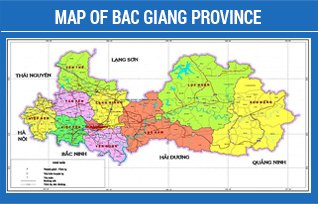Bac Giang: Important shipping traffic point in the north
Bac Giang is a mountainous and midland province located at the transition among the northeastern provinces, the Red River Delta provinces and Hanoi Capital. Being situated at the exchange central of the key economic triangle region Hanoi - Hai Phong - Quang Ninh; Bac Giang is also an important shipping traffic point in the north.

Diversifying types of traffic
In term of road traffic, until the end of 2014, the total length of roads in Bac Giang Province was 10,784.79 km, including 5 National Highways No. 1A, 31, 37, 279 and 17 crossing with total length of 308.9 km; 18 provincial roads with total length of 367.66 km; 736.9 kilometers of district roads; 2053.72 kilometers of communal roads; approximately 308.18 kilometers of urban roads and 7009.43 kilometers of rural one. In addition, the system also has service roads in industrial areas and interior field roads.
Inland water navigation has three major rivers (including Thuong, Cau and Luc Nam rivers); of which, 222 kilometers managed by central authorities and 130 km kilometers managed by local ones.
Railway traffic includes three routes as follows: Hanoi - Dong Dang with the length of 167 km (40 km through Bac Giang province); Kep - Halong with the length of 106 km (32.77 km through Bac Giang province) and Kep - Luu Xa (not under operation).
Regarding to transport activities, Bac Giang currently has 17 inter-provincial haulage routes and 9 intra-provincial ones. Harbor and inland waterway port systems are relatively modern, synchronized enough to load and unload cargo for vessels of large tonnage, such as A Lu Port; Port of Ha Bac Fertilizer and Chemicals Co., Ltd, Dam Port, Tuan Port, etc. Of which, A Lu Port having an area of 20,000 meter square with the length of about 200 meter and two warehouses with total area of 4.440m2 can handle about 250 thousand tons of goods per year; the specialized port of Ha Bac Fertilizer and Chemicals Co., Ltd has capacity of transferring about 70 to 100 thousand tons of goods a year and dozens of small and medium sized ports and wharves serving for local transportation needs have contributed to the diversification of transportation forms, reducing pressure on road traffic in the province.
Planning synchronically
Recognizing the role of transport in the cause of socio-economic development, Bac Giang Provincial People's Committee issued Decision No.71/QD-UBND dated 14 March 2012 approving transport traffic development planning in Bac Giang province to 2020 and with a vision to 2030.
In July 2015, Bac Giang province issued a resolution approving the "Amendment to transport traffic development planning in Bac Giang province to 2020 and with a vision to 2030"
.

Accordingly, the goal of 2015 - 2020 period is to focus on upgrading national highways, provincial roads, some district roads, roads to the center of difficult communes, investing in constructing some new roads to connect industrial zones with residential areas and urban regions, developing inland waterways and railways to meet the transportation demand of freight and passengers.
In the period of 2021 - 2030, it aims to complete and gradually modernize the infrastructure of transport traffic to improve service quality, ensure a smooth internal and external transport network.
Specifically, regarding to infrastructure development, it is supposed to complete Hanoi - Lang So national highway with 2 to 4 lanes; deploy the road-bed construction of Hanoi belt-line road V with 4 to 6 lanes; renovate and upgrade with the target of provincial roads in the plain area reaching minimum standards of grade IV or higher; in mountainous area reaching minimum standard of grade V.
Transferring some important district roads into the provincial roads, opening some new routes, sections in necessary areas; hardening about 87 to 90% the surface of district roads; 58.5 to 65% of communal roads; upgrading hamlet roads to reach the standard of rural roads type B and hardening 55 to 60%, its surface, carrying out maintenance on 70% of the volume.
Urban traffic development is built in line with socio-economic development planning, spatial development and infrastructure layout of the municipality.
In addition, to build and expand 6 new coach station, upgrade the current ones, open 51 more interprovincial transport routes connecting with 37 provinces and cities nationwide; build inland ports to meet the need for storage and distribution of goods in Dong Son (Bac Giang city) and Kep town (Lang Giang district) with a scale of 30 hectares by 2020 and 50 hectares by 2030; establish a logistics center in Bac Giang city and Lang Giang district (along National Highway No.1).
Regarding to inland waterways, to dredge and regulate river flows to ensure safety for large loading ships, construct new ports, harbors and passenger piers and combine water navigation with road traffic to meet the transport demand better.
In term of the development of transportation and means, volume of road freight transport is expected to reach 25.4 million tons by 2020, 77 million tons by 2030; the average growth is 8.28% per year by 2020 and 11.73% per year in the period of 2021-2030. The volume of passenger transport aims to reach 47.3 million passengers by 2020, 139.4 million passengers by 2030, average growth is 11.69% per year by 2020, 11,43% per year in the period of 2021- 2030. Up to 2020, it must be ensured to meet about 40% of urban public passenger transport needs.
The volume of inland waterway freight traffic is aimed to reach 3.97 million tons by 2020 with an average annual growth of 11.97% and 6.37 million tons by 2030 with an average annual growth of 18.5%.
The volume of goods carriage by rail is estimated at 168, 970 tons by 2020 with an average annual growth of 18%; the passenger transport volume by 2020 is likely at 105,000 participations with an average annual growth of 11%.

